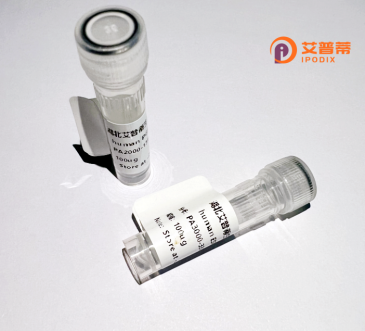
| 纯度 | >90%SDS-PAGE. |
| 种属 | Human |
| 靶点 | MTSS1L |
| Uniprot No | Q765P7 |
| 内毒素 | < 0.01EU/μg |
| 表达宿主 | E.coli |
| 表达区间 | 1-747 aa |
| 活性数据 | METAEKECGA LGGLFQAIVN DMKSSYPIWE DFNSKATKLH SQLRTTVLAA VAFLDAFQKV ADMATNTRGA TRDIGSALTR MCMRHRSIET KLRQFTNALL ESLINPLQER IEDWKKAANQ LDKDHAKEYK RARHEIKKKS SDTLKLQKKA RKELLGKGDL QPQLDSALQD VNDMYLLLEE TEKQAVRRAL IEERGRFCTF ITFLQPVVNG ELTMLGEITH LQGIIDDLVV LTAEPHKLPP ASEQVIKDLK GSDYSWSYQT PPSSPSSSSS RKSSMCSAPS SSSSAKGGGA PWPGGAQTYS PSSTCRYRSL AQPATTTARL SSVSSHDSGF VSQDATYSKP PSPMPSDITS QKSSSSASSE ASETCQSVSE CSSPTSDWSK VGSHEQPSGA TLQRRKDRVE LLRDTEPGPA SGGTLGPSGE EAPRPRMSPA TIAAKHGEEV SPAASDLAMV LTRGLSLEHQ KSSRDSLQYS SGYSTQTTTP SCSEDTIPSQ GSDYDCYSVN GDADSEGPPE FDKSSTIPRN SNIAQNYRRL IQTKRPASTA GLPTAGLPTA TGLPSGAPPG VATIRRTPST KPTVRRALSS AGPIPIRPPI VPVKTPTVPD SPGYMGPTRA GSEECVFYTD ETASPLAPDL AKASPKRLSL PNTAWGSPSP EAAGYPGAGA EDEQQQLAAN RHSLVEKLGE LVAGAHALGE GQFPFPTALS ATPTEETPTP PPAATSDPPA EDMLVAIRRG VRLRRTVTND RSAPRIL |
| 分子量 | 79.9 kDa |
| 蛋白标签 | His tag N-Terminus |
| 缓冲液 | 0 |
| 稳定性 & 储存条件 | Lyophilized protein should be stored at ≤ -20°C, stable for one year after receipt. Reconstituted protein solution can be stored at 2-8°C for 2-7 days. Aliquots of reconstituted samples are stable at ≤ -20°C for 3 months. |
| 复溶 | Always centrifuge tubes before opening.Do not mix by vortex or pipetting. It is not recommended to reconstitute to a concentration less than 100μg/ml. Dissolve the lyophilized protein in distilled water. Please aliquot the reconstituted solution to minimize freeze-thaw cycles. |
以下是关于重组人MTSS1L蛋白的3篇代表性文献及其摘要简述:
---
1. **文献名称**:*MTSS1L regulates cancer cell metastasis via RhoC-mediated cytoskeletal remodeling*
**作者**:Liu Y et al.
**摘要**:该研究揭示了MTSS1L蛋白通过结合并激活RhoC GTP酶调控细胞骨架重组,抑制肿瘤细胞的迁移和侵袭能力,证实其在乳腺癌转移中的抑癌作用。
---
2. **文献名称**:*Structural and functional characterization of MTSS1L as a membrane curvature-sensing protein*
**作者**:Bompard G et al.
**摘要**:本文解析了MTSS1L蛋白的IMD结构域通过感应细胞膜曲率变化介导膜变形,证明其参与细胞伪足形成和胞内囊泡运输的分子机制。
---
3. **文献名称**:*Downregulation of MTSS1L promotes epithelial-mesenchymal transition in colorectal cancer*
**作者**:Wang X et al.
**摘要**:研究发现MTSS1L在结直肠癌中表达下调,其缺失通过激活Wnt/β-catenin信号通路促进上皮-间充质转化(EMT),揭示了其作为转移抑制因子的潜在标志物价值。
---
提示:更多相关研究可通过PubMed搜索关键词“MTSS1L AND (metastasis OR cytoskeleton)”获取。
MTSS1L (Metastasis Suppressor 1-Like), also known as Missing in Metastasis (MIM) or MIM-B, is a cytosolic protein involved in regulating actin cytoskeleton dynamics and membrane remodeling. It belongs to the inverse Bin-Amphiphysin-Rvs (I-BAR) domain protein family, characterized by its ability to sense and induce curvature in cell membranes. MTSS1L contains an N-terminal I-BAR domain responsible for membrane binding and deformation, a central proline-rich region for protein-protein interactions, and a C-terminal IMD (IRSp53/MIM homology domain) that binds actin regulators.
Functionally, MTSS1L acts as a scaffold protein, coordinating signaling pathways that influence cell migration, morphogenesis, and vesicle trafficking. It interacts with actin-binding proteins like WASP/WAVE complexes and small GTPases (e.g., Rac, Cdc42), linking membrane dynamics to cytoskeletal reorganization. Studies suggest its dual role in tumor biology: while initially identified as a metastasis suppressor due to downregulation in certain cancers, it may exhibit context-dependent oncogenic properties by promoting invasive protrusions in others.
Recombinant MTSS1L protein is often produced in bacterial or mammalian expression systems for structural studies, in vitro actin polymerization assays, and exploring its regulatory mechanisms in diseases like cancer and neurological disorders. Its unique membrane-curving ability also makes it a tool for studying membrane mechanics in cellular processes.
×